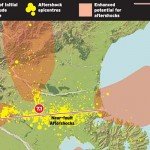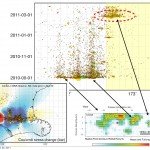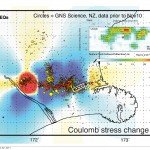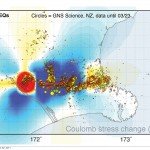A new study suggests that geological stress caused by the September Darfield quake may have ‘loaded’ the fault that ruptured in the February Canterbury quake. New Zealand geologists agree this is possible but are treating the research with caution.
A team of Italian Seismologists have analysed ground deformation data from a Japanese satellite to investigate how the 7.1M Darfield quake of September 4 2010 might have contributed to the 6.4M Christchurch quake of February 21 2011.
The research, published in the Nature journal Scientific Reports, is titled ‘Did the September 2010 (Darfield) earthquake trigger the February 2011 (Christchurch) event?‘.
The analysis used by the researchers relies on Coulomb Stress Triggering theory – an approach which assumes that after an earthquake, the stress does not dissipate but it propagates in the surrounding area, potentially increasing the occurrence of further earthquakes.
The authors of the study ultimately concluded that the Darfield quake to some extent contributed to the Christchurch fault rupture in February 2011:
“With our analysis we cannot state whether Earthquake-2 [Christchurch, Febuary 2011] was (or was not) extremely unlikely to occur without the preceding Earthquake-1 [Darfield, September 2010]; however, the outcome of our work is that Earthquake-1 has loaded the Earthquake-2 fault, bringing it closer to failure.”
The researchers were unable to determine whether the Christchurch quake was an aftershock of the Darfield quake or a mainshock seismic event in its own right.
The Science Media Centre gathered comment from New Zealand earthquake experts on the study.
Geoscientist Professor Kevin Furlong, of Penn State University, who was working in Christchurch at the time of the quakes, said:
“Regarding the Scientific Reports article (I hadn’t seen this previously) on the possible triggering of the February event by the September event. The results shown are very similar to the work we did using our Finite Fault model of the Darfield event to solve for the stress changes. – those results were included in the opinion piece I wrote for “The Press” in Christchurch in January – basically an article explaining where the aftershocks would be expected to occur (and what was driving them).
 “I had included a simplified map (see at right, click to enlarge) in that newspaper piece. So it is not really much of a surprise. The conclusions in this report are pretty much similar to those we found earlier – but hadn’t published it previously – although it was presented at several scientific meetings (the EGU in April and the IUGG in June) – basically it is consistent with all of the results we have found on the fault rupture and its stress effects.
“I had included a simplified map (see at right, click to enlarge) in that newspaper piece. So it is not really much of a surprise. The conclusions in this report are pretty much similar to those we found earlier – but hadn’t published it previously – although it was presented at several scientific meetings (the EGU in April and the IUGG in June) – basically it is consistent with all of the results we have found on the fault rupture and its stress effects.
“I guess I am surprised that Nature thought this was a big deal.
“In terms of the stress models – they identify where stresses have been increased and thus if there are conditions that favor continued earthquake activity (an appropriate fault and the right background stresses) then we have the activity -as was the case. But in terms of recognising that a large event such as the February event was likely – that simply is not possible from the information from the stress modeling. So back in the December – February time frame, although we felt confident in explaining why there were more aftershocks in the Christchurch region, and we felt we knew why. We could not have anticipated the scale of the events to follow”.
[The images below] “shows that the February event was right in the max change (the yellow zone to the east) and was filled in by the subsequent events.”
Click on an image for more detail. Provided by Prof Furlong.
Dr Mark Quigley, Senior Lecturer in Active Tectonics and Geomorphology, University of Canterbury, said:
“The Italian study on the Canterbury earthquake sequence addresses a question that several New Zealand scientists have been considering since Feb 22; did fault slip related to the M 7.1 Darfield earthquake trigger the Feb 22 Christchurch earthquake by changing the stress state on the Port Hills Fault?
“The Italian authors argue that changes in the shape of the Earth’s crust resulting from the Sept event decreased the stresses in the shallow part of the Port Hills Fault and increased stresses on the deeper (>5km) depth part of the Port Hills Fault, thus bringing forward the ‘due date’ of this earthquake.
“Earthquake triggering is a complicated process involving both ‘static’ and ‘visco-elastic’ stress changes resulting from deformation and subsequent relaxation of the crust and mantle during and after earthquakes, and ‘dynamic’ stress changes relating to the effects of passing seismic waves on adjacent fault zones. Both processes might have played a role in bringing forth the due date of the Feb 22 earthquake, but without an a priori understanding of the fault structure beneath the Port Hills it would not have been possible to provide a robust estimate of the earthquake potential here beyond the aftershock forecasts that were put forth publically by NZ scientists.
“The Italian study appears to have several limitations, including an incorrect location for the Feb 22 earthquake hypocenter (their Fig 3) that they argue coincides with a maximum change in static stress from the Sept earthquake on the Feb 22 fault plane (this does not seem to be the case based on my assessment of their model). Ongoing studies using a wealth of locally based data will provide further insights into the roles of stress triggering and fault interaction amongst the sources of the Sept, Feb, and June earthquakes.”
Prof Martha Savage, Professor of Geophysics, Victoria University of Wellington, said
“This study uses analysis tools that have become relatively common in the last ten or so years to investigate the triggering of earthquakes. I have no problem with the idea that the Darfield earthquake triggered the Christchurch earthquake; indeed it is quite common for large aftershocks to occur and the Darfield sequence did seem to evolve over time to have more earthquakes in the eastern than the western side. The Coulomb modelling seems quite similar to figures I’ve seen GNS scientists give in seminar presentations although I have not seen anything written on it before.
“I do however think the evidence in this particular paper is fairly weak. For instance, you can see in figure 3 that there are a lot of aftershocks in the blue regions where there shouldn’t be so many if everything were perfect in the model. And they have not provided any statistical analysis to state whether the differences in seismicity between the regions are significant. Also part of the Christchurch fault plane is in a region that is supposed to be inhibiting earthquakes.
“Nonetheless, the paper emphasises that indeed, earthquakes can be triggered by very tiny changes in stress and it is going to be quite difficult to figure out exactly what can cause any particular earthquake. Also aftershock sequences last a long time and that needs to be understood in planning for when to rebuild Christchurch.”
Prof Euan G C Smith, Professor of Geophysics, Victoria University of Wellington said:
“I’m not terribly impressed with the forthcoming paper. Coulomb stress triggering is all the rage (in the absence of any other triggering mechanism), but the association between red and blue zones (fig 3 b) and the presence and absence of aftershocks is rather weak.
“The method requires a lot of assumptions which are not always acknowledged. The stress increment on the Christchurch (22 Feb) faults is ~0.01 MPa (0.1 Bar) which is very small. And since Coulomb theory is a static theory, it is silent on why we had to wait 5 months for the 22 Feb event.
“The paper notes (p5) something I was personally aware of because I was talking to a journalist at the time: “A magnitude 5.1 aftershock occurred on September 8 nearby [within 2km! ES] the epicenter of the February 21 event. ” This was undoubtedly an aftershock – triggered earthquake. So why did it take another 5 months for a 6.3 to happen in virtually the same place? No-one (i.e. all the seismological community) has a theory for this.
“The occurrence of a ‘late’ large aftershock is not that rare. In 1942, two magnitude 7 earthquakes occurred near Masterton on 24 June and 1 August. In December 1942 a mag ~6 earthquake occurred just east of Masterton.”
Feel free to use these quotes in your reporting. Please contact the SMC to speak with an expert (smc@sciencemediacentre.co.nz, 04 499 5476)


